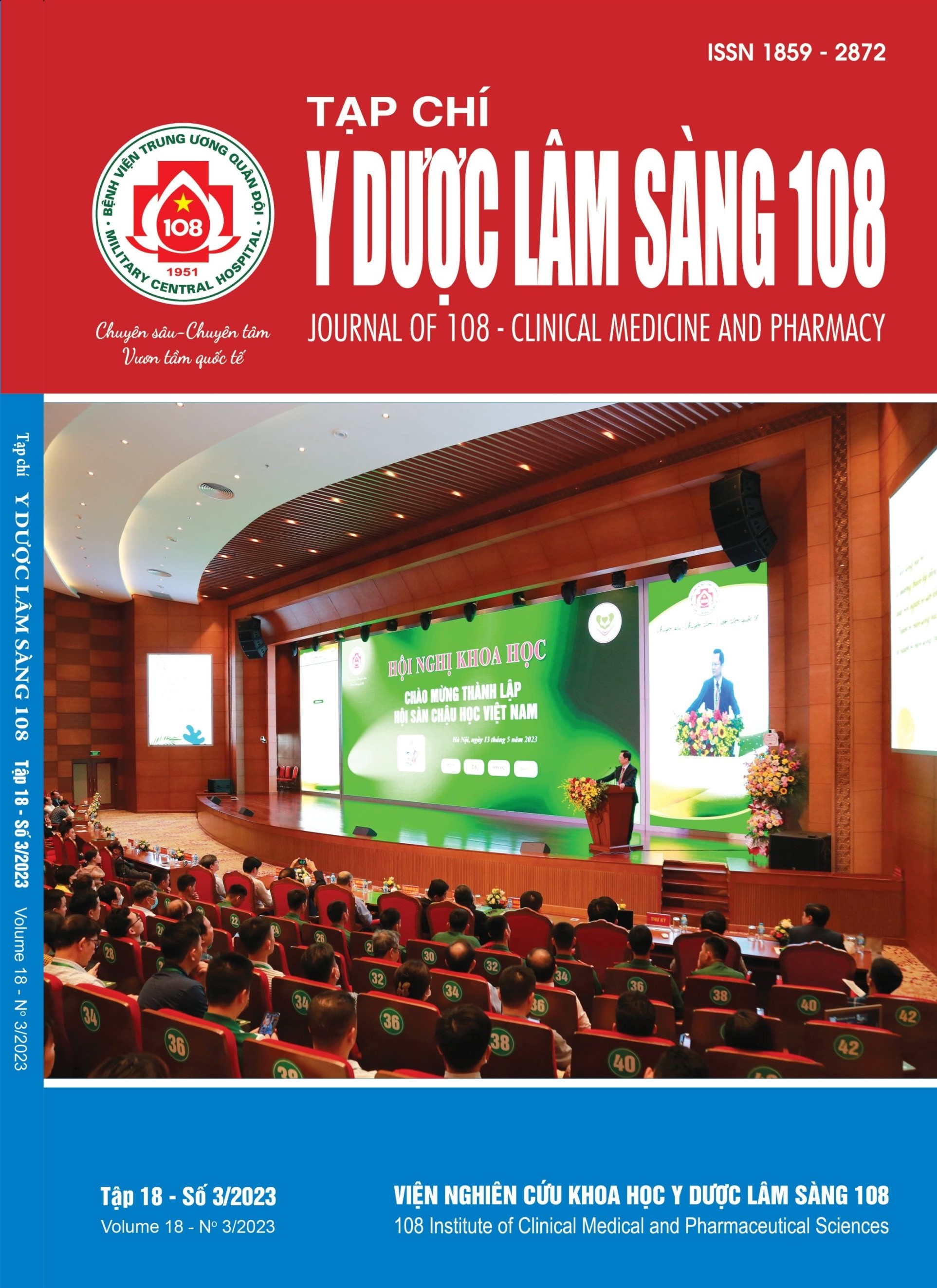Relation between mechanical dispersion by speckle tracking echocardiography and ventricular arrhythmias and risk of sudden cardiac death in hypertrophic cardiomyopathy
Main Article Content
Keywords
Abstract
Objective: To investigate the relation between mechanical dispersion assessed by speckle tracking echocardiography (STE) and ventricular arrhythmias and risk of sudden cardiac death in patients with hypertrophic cardiomyopathy (HCM). Subject and method: In this cross-sectional study, HCM patients were consecutively recruited in Vietnam National Heart Instutute, Bach Mai Hospital. Inclusion criteria were a definite diagnosis of HCM according to HCM guidelines. We excluded patients with prior septal reduction therapy, coronary artery disease, and myocardial hypertrophy of other causes, e.g. severe valvular disease, myocardial storage disease, and hypertension. All HCM patients underwent clinical examination, 24h Holter monitoring and STE. Mechanical dispersion (PSD) was defined as the standard deviation of time to peak negative strain in 17 left ventricular segments. Five years sudden cardiac death (SCD) risk score (%) was evaluated according to the HCM guidelines by the European Society of Cardiology 2014. Result: From 8/2019 to 11/2020, 53 HCM patients (27 men [50.9%] and 26 women [49.1%]) were included. Mean age 46.3 ± 16.5. Mechanical dispersion in HCM patients was two-fold higher than normal value. HCM patients with ventricular arrythmias had higher PSD than patients without ventricular arrythmias (127.2 ± 43.4ms vs. 71.3 ± 43.6ms, p=0.027). Among three groups of HCM patients according to 5 years SCD risk score, there was a significant difference in PSD: High risk group had mean PSD 131.1 ± 14.1ms, higher than moderate risk group (114.1 ± 27.9ms), higher than low risk group (105.1 ± 20.2ms), p=0.045. PSD was associated with ventricular arrhythmias, OR=1.67, 95% CI: 1.08-2.21, p=0.003, cut-off PSD = 79ms predicted ventricular arrhythmias with sensitivity 81.3%, specificity 89.0%, p=0.002. Conclusion: Mechanical dispersion by speckle tracking echocardiography was a markers of ventricular arrhythmias and related to risk of sudden cardiac death in HCM patients. Strain echocardiography may improve risk stratification in HCM
Article Details
References
2. Kocovski L, Fernandes J (2015) Sudden cardiac death: a modern pathology approach to hypertrophic cardiomyopathy. Archives of Pathology and Laboratory Medicine 139(3): 413-416.
3. Elliott PM, Anastasakis A et al (2014) 2014 ESC Guidelines on diagnosis and management of hypertrophic cardiomyopathy: the Task Force for the Diagnosis and Management of Hypertrophic Cardiomyopathy of the European Society of Cardiology (ESC). European Heart Journal 35(39): 2733-2779.
4. Haland TF, Almaas VM, Hasselberg NE et al (2016) Strain echocardiography is related to fibrosis and ventricular arrhythmias in hypertrophic cardiomyopathy. European Heart Journal-Cardiovascular Imaging 17(6): 613-621.
5. Pedersen CT, Kay GN, Karman J et al (2014) EHRA/HRS/APHRS expert consensus on ventricular arrhythmias. Europace 16: 1257-1283.
6. Lang RM, Badano LP, Mor-Avi V et al (2015) Recommendations for cardiac chamber quantification by echocardiography in adults: An update from the American Society of Echocardiography and the European Association of Cardiovascular Imaging. J Am Soc Echocardiogr 28: 1-39.
7. Ayoub C, Geske JB, Larsen CM, Scott CG, Klarich KW, Pellikka PA (2017) Comparison of Valsalva maneuver, amyl nitrite, and exercise echocardiography to demonstrate latent left ventricular outflow obstruction in hypertrophic cardiomyopathy. The American Journal of Cardiology 120(12): 2265-2271.
8. Moon I, Lee SY, Kim HK et al (2020) Trends of the prevalence and incidence of hypertrophic cardiomyopathy in Korea: A nationwide population-based cohort study. PloS one 15(1):0227012.
9. McLeod CJ, Ackerman MJ, Nishimura RA, Tajik AJ, Gersh BJ, Ommen SR (2009) Outcome of patients with hypertrophic cardiomyopathy and a normal electrocardiogram. Journal of the American College of Cardiology 54(3): 229-233.
10. Villa AD, Sammut E, Zarinabad N et al (2015) Microvascular ischemia in hypertrophic cardiomyopathy: new insights from high-resolution combined quantification of perfusion and late gadolinium enhancement. Journal of Cardiovascular Magnetic Resonance 18(1): 1-11.
11. Rust EM, Albayya FP, Metzger JM (1999) Identification of a contractile deficit in adult cardiac myocytes expressing hypertrophic cardiomyopathy-associated mutant troponin T proteins. The Journal of Clinical Investigation. 103(10): 1459-1467.
12. Ozawa K, Funabashi N, Takaoka H et al (2015) Characteristic myocardial strain identified in hypertrophic cardiomyopathy subjects with preserved left ventricular ejection fraction using a novel multi-layer transthoracic echocardiography technique. International Journal of Cardiology 184: 237-243.
13. Jalanko M, Tarkiainen M, Sipola P et al (2016) Left ventricular mechanical dispersion is associated with nonsustained ventricular tachycardia in hypertrophic cardiomyopathy. Annals of Medicine 48(6): 417-427.
14. D'Andrea A, Caso P, Severino S et al (2005) Association between intraventricular myocardial systolic dyssynchrony and ventricular arrhythmias in patients with hypertrophic cardiomyopathy. Echocardiography: A Journal of Cardiovascular Ultrasound and Allied Techniques 22(7): 571-578.
15. Haugaa KH, Grenne BL, Eek CH et al (2013) Strain echocardiography improves risk prediction of ventricular arrhythmias after myocardial infarction. JACC: Cardiovascular Imaging 6(8): 841-850.
16. Candan O, Gecmen C, Bayam E, Guner A, Celik M, Doğan C (2017) Mechanical dispersion and global longitudinal strain by speckle tracking echocardiography: predictors of appropriate implantable cardioverter defibrillator therapy in hypertrophic cardiomyopathy. Echocardiography. 34(6): 835-842.
 ISSN: 1859 - 2872
ISSN: 1859 - 2872
